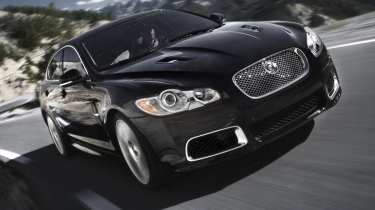Jaguar XFR + XKR
New 5-litre V8s, 503bhp XFR and revised XKs at Detroit
It has hardly been the best-kept of secrets, but visitors to Detroit will be the first to see the new R version of the Jaguar XF plus the revised range of XKs. All these cars get Jaguar's all-new 5-litre V8 engine, which replaces the 4.2-litre unit and has just the cylinder-head bolts and the exhaust tappets in common with it. Chief engines engineer Malcolm Sandford says the V8s are the most efficient engines in their class. The supercharged version makes 503bhp, plus 461lb ft of torque all the way from 2000rpm to 5000rpm, yet it gets under 300g/km CO2 while propelling the Jaguar in which it is fitted to 60mph in under five seconds. Direct injection is the key, allowing a higher compression ratio and better control of fuel mixture concentrations. Most DI engines have the injector at the side of the combustion chamber, but this one places it at the centre next to the spark plug. One thing that's missing from the supercharged engine is the characteristic whine. Sandford hates it: 'It's the sound of imperfect machinery and it shouldn't be there,' he says. So there's a new Eaton 'Twin Vortex' supercharger with four lobes per rotor instead of three, which is more efficient and soaks up less energy to drive it. The water-cooled intercooler can absorb up to 30kW of heat from the intake air. Both engines have a neat water-cooled oil cooler nestling in the vee, and both have less internal friction than any rival engine according to data from an independent engineering assessor commissioned by Jaguar. The naturally-aspirated V8 produces strong figures, too: 380bhp and the same number of lb ft, the latter again strong from low revs. All four of its camshafts have a very clever design of variable valve timing, using the torque generated by the camshaft itself as the valve springs try to force the cam lobes to move round. This uses less energy and generates a quicker response than the usual oil-pressure-fed system. The inlet camshafts also have variable lift, using a hydraulic pin to lock the tappet in one of two shapes as needed to engage with one of two camshaft profiles. The new engines, and the 3.0-litre twin-turbo diesel recently announced, are joined to revised ZF automatic transmissions which should feel more DSG-like than ever, thanks to crisper shifts and more locking-up of the torque converter. With its supercharged V8 the £59,900 XFR virtually matches BMW's V10 M5 for power while producing more torque at lower, more usable revs. This new R-car has deeper front and rear valances, with chrome mesh in the lower air intakes, and subtle sill extensions with a gentle twist along their length. Wheels are 20in diameter and bear 'Jaguar Supercharged' lettering, and exhaust gases exit through four fat pipes. The bonnet has a pair of vents to let the hot air out. It's all quite understated, as is the interior which gets some new dark wood and aluminium treatments and new body-hugging front seats. Understated, that is, unless you go for the Red Zone seat facings. The former CATS suspension, with its two automatic stiffness settings, is replaced by a continuously-variable Bilstein system using sliding valves. The XF SV8, incidentally, has disappeared from the range although Jaguar insists the XFR is not its replacement, being an altogether harder-edged car. The new XKR is mechanically almost exactly the same as the XFR, and both get a new electronic active differential which functions much like Ferrari's version. So if there's a tail slide, it can divert torque to the outside rear wheel to help correct it instead of relying on the electronic stability system to brake the inside rear wheel. With the stability system switched off, both Jaguars are set up to allow progressive power slides with the electronic differential keeping torque where it needs to be. You can tell a 5-litre XK by the new outer vents on the front valance, new LED tail lights and, inside, the XF-type Jaguar Drive Control, the round gearshift selector which rises out of the centre console on start-up. The XKR gets the new 'supercharged' wheels, too. As for an XK 3.0 turbodiesel, all the engineers will say is, 'It's a good idea.' But the body language suggests it's rather more than that.
You can read more about the cars and stars from the 2009 Detroit motor show.
See the Jaguar video unveiling here



